Scentlogix Detection Training Aids Double Blind Study;
“Sometimes thinking outside the box means thinking about what’s inside the box”
written by Nate Harves and Lorna thomas
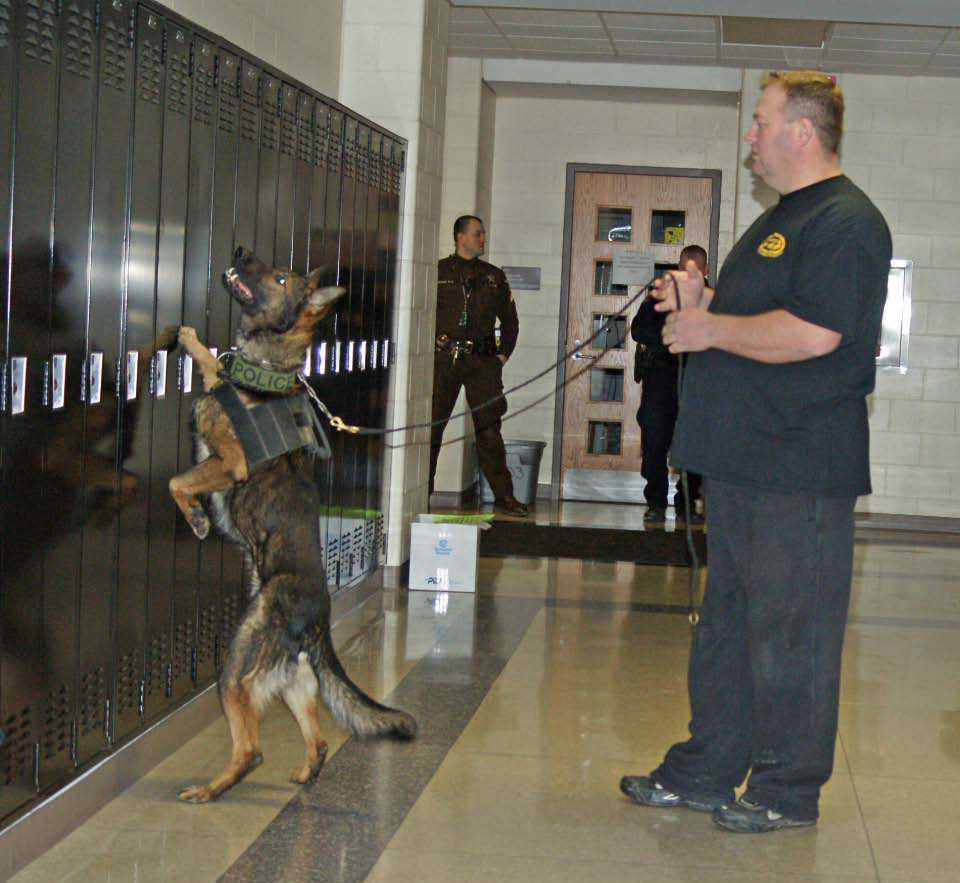
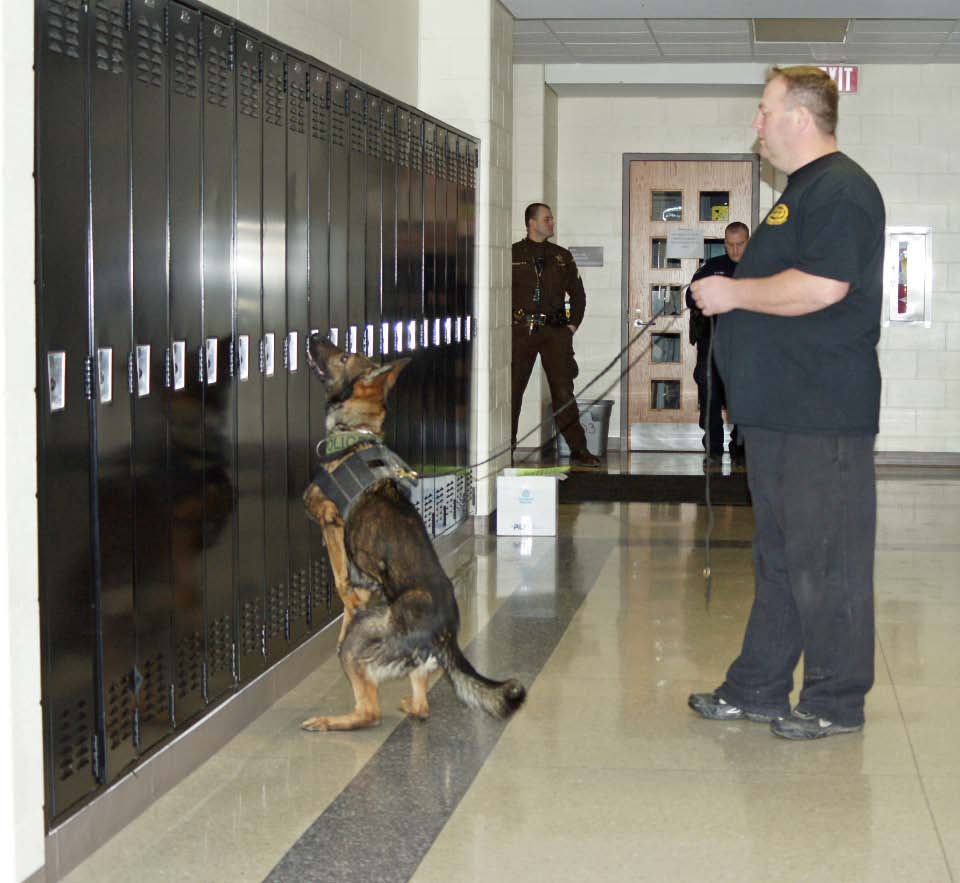
Nate working K9 Paco on lockers
In May of 2010, I had the opportunity to listen to a speaker at a K9 Conference and observe his presentation to a room full of over 100 Police K9 handlers. The presentation was on the Scentlogix Detection Training Aids, and the speaker was David Adebimpe, the founder and CEO of Polymath Interscience. David tried to convey as best he could to this overflowing room of street cops what the philosophies and scientific approaches were to the development of his detection training aids. I am not ashamed to admit that although he did a great job explaining the science behind his work I struggled to keep up as did most everyone in the room. You see, David holds an interdisciplinary Ph.D. in Synthetic Organic Chemistry, Materials Science and Chemical Engineering, an M.Phil. in Synthetic Organic Chemistry, and a B.Sc. with Honors in Biochemistry with Psychology. As I excitedly took notes on what I believed to be an innovative, fascinating, and cutting edge benefit to the detection community, I noticed something in the room; many had dropped off. With skeptical looks, some even left the room, I think not out of disrespect to David and his product, but rather due to the fact that they wanted to learn something and had admitted like I had, that they’d never be a nano-physicist like David and weren’t really following what he was saying as completely as they’d like. I took in all I could, but had to admit something else. There was the cynical cop in me that, although extremely curious about what was being lectured upon, still had an underlying doubt and distrust. Cops can be very “I don’t buy it….. that’s not the way so and so does it…. show me!” Frequently, police need to hear it from other police for it to really be true, right? And David was no street cop. He was only a nano-physicist. But what he was saying seemed very possible to the dog trainer in me. It just might work and that excited me.
I would love to go into the science behind what David does but I have no doubt I would butcher or do a disservice to his years of work and knowledge. After all, his Cliff-note version dummied down to street cops was still two hours of lecture, PowerPoint, graphs, charts, and handouts. But I have to attempt to touch upon what he did as I understood it. David explained how he identified qualities within a full odor spectrum of narcotics. Through research and clinical science he came to believe the olfactory system to basically be a heat receptor. When it identifies a heat signature pattern on this nano-scale the nose believes it is the item. It believes it completely.
K9 Paco showing that perfect stare behavior!
I have trained around and used other so called “Pseudo” detection training aids. I would like to say though, in my opinion, I don’t consider this really a pseudo detection aid. Pseudo is defined as “an adjective; not actually but having the appearance of; pretended; false or spurious; sham. Almost, approaching, or trying to be.” The science behind ScentLogix supports, through David’s research, that the nose doesn’t think it’s close to, or kind of like; the nose completely believes it IS. The product mimics one hundred percent the qualities that the olfactory system can identify in the full scent spectrum. Most pseudo detection aids get as close to what we think the dogs smell when they sniff the aid. I have seen dogs trained on pseudo walk live narcotic and vice versa. To some dogs it was close enough to alert to and to others it was definitively NOT what they were imprinted and foundation trained on. It was not uncommon to get false negatives and false positives in your alerts. Because of this, some departments and agencies and entire certification programs and schools completely avoid pseudo detection aids. The trumpet is sounded that “we train on the REAL thing.”
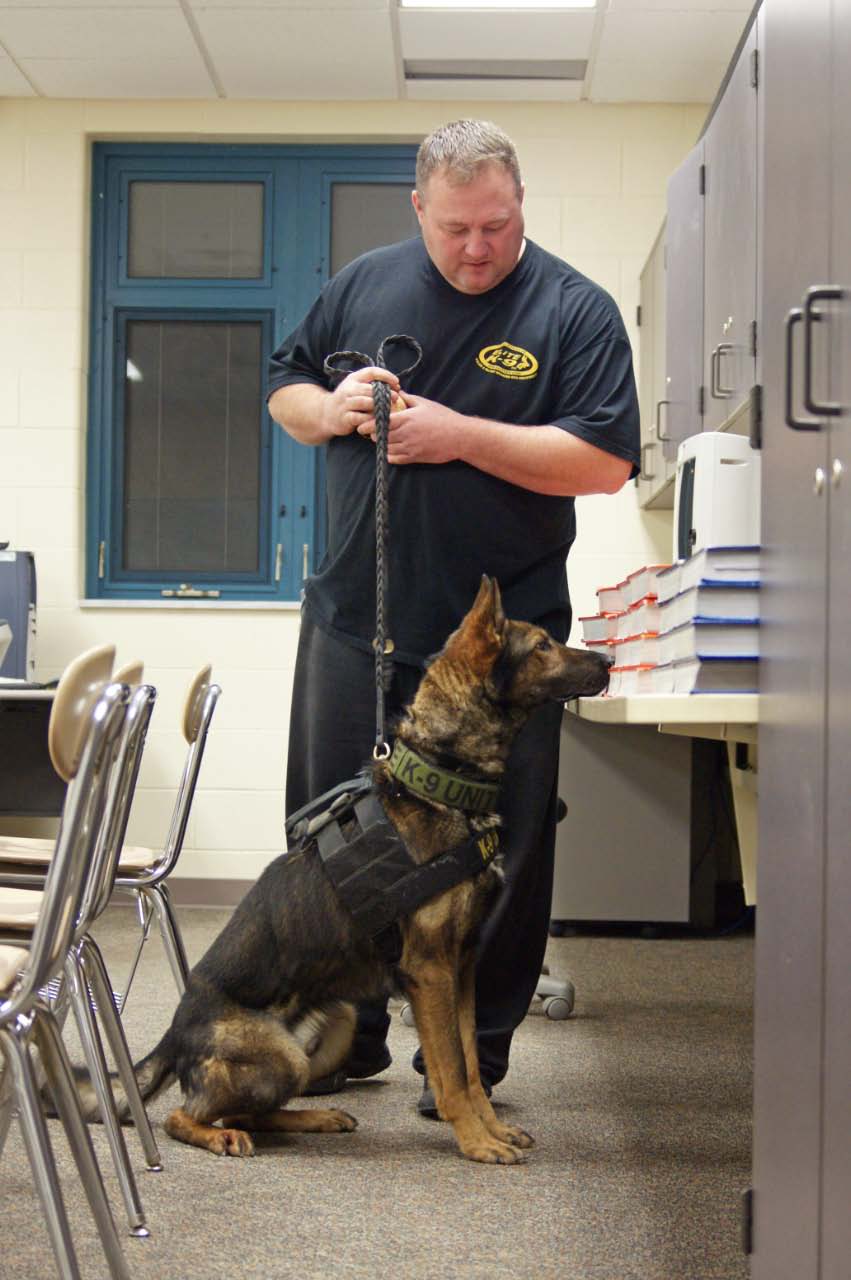
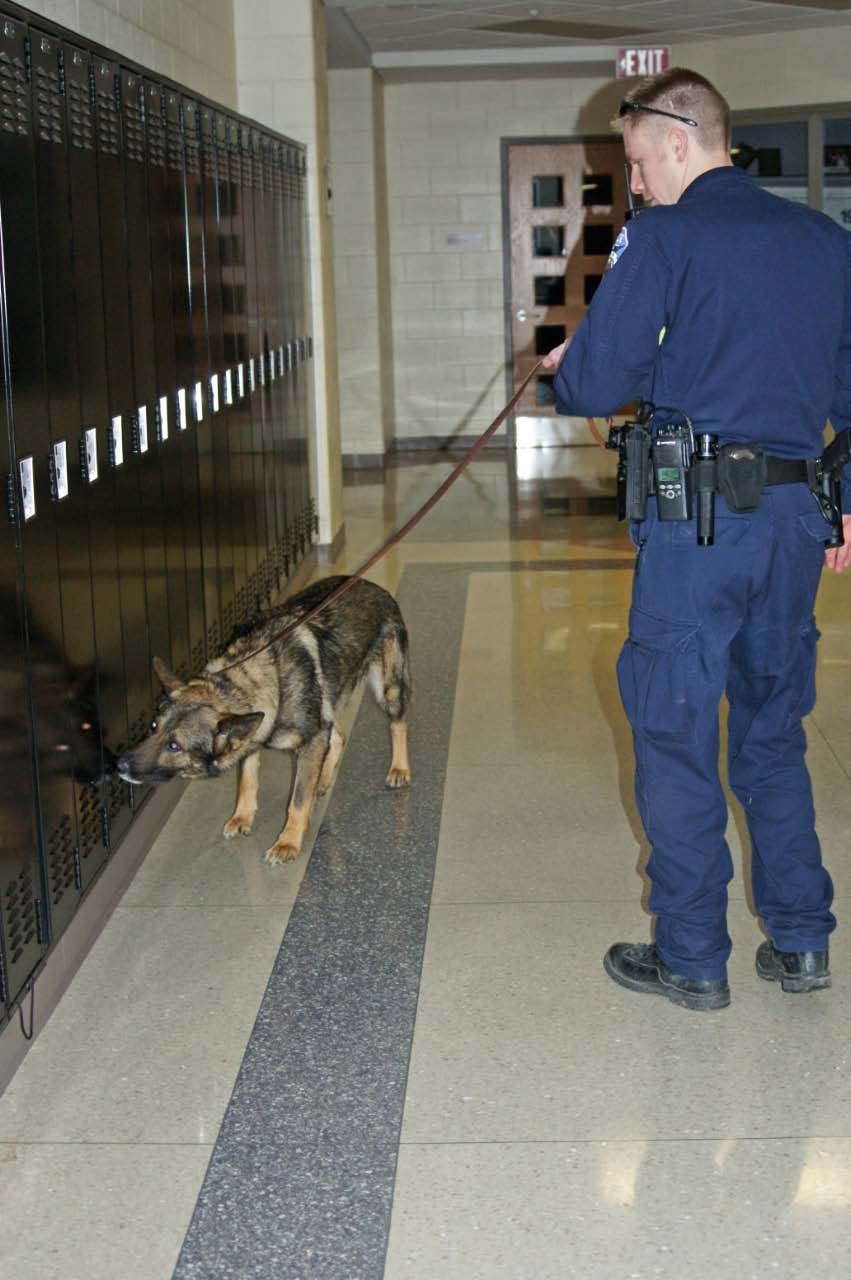
Avon K9 Tom Owens works the lockers with his K9
The problem with the real thing however is that you can’t just drive to the local pharmacy drive thru and say “Yes, I would like 2 kilos of cocaine, ten pounds of marijuana, etc.” Not only can the training aids be difficult to attain through DEA licensing, but the departmental regulations behind maintaining chain of custody on already propertied narcotics can be very restrictive. Go to your Chief or Sheriff and tell them “Oops! I seem to have misplaced 3 grams of cocaine from the property room” and see what kind of look you get. Additionally, you as the handler and the dog as the locating tool are commonly in contact with these dangerous and elicit substances. And that’s just the narcotics. Think narcotics are hard to find and dangerous? Drive to the local Walmart and ask them for six pounds of C4 and some det cord. Those looks will be better than the previous Chief or Sheriff reactions. So therein lies the problem with training with the aids you really want and some of the reasons why many have made or considered the switch to pseudo. None of these reasons are valid with the Scentlogix Detection Aids. They are not hard to come by, they are not dangerous or elicit, and they require no oversight licensing or chain of custody. You lose explosive or narcotics, or handle them wrong, and you have a very big problem. Scentlogix Detection Aids are safe to the handler, the dog, and the environment in which they are deployed. And that’s not the best part. The best part is your dog will completely believe they are in fact those substances. All of the pro’s, with none of the con’s.
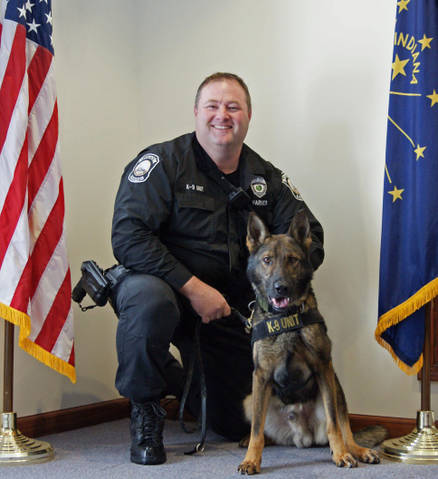
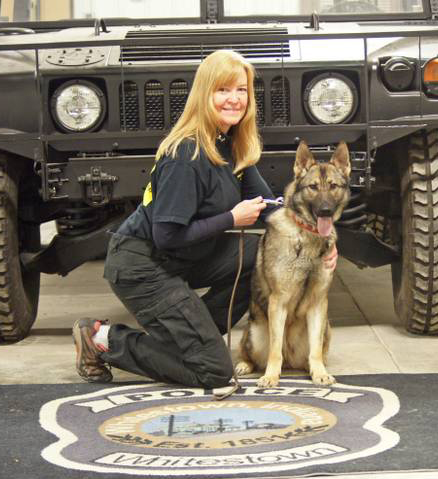
Authors Nate Harves with K9 Paco and Lorna Thomas with K9 Nova von den Sportwaffen
David also explained how the Scentlogix Detection Aids are designed to emanate a one hundred percent pure narcotic odor. I was really struck by this because here was a scientist, thinking only through a scientific perspective, identifying a problem I had complained about for years as a dog handler. It was gratifying to hear him identify it as a valid scientific concern in his olfactory scent detection laboratory studies. I had long argued that when you use live narcotic, the anthropomorphic part of us (as humans applying human thought or attributes to things not human, such as dogs) wanted to believe when we imprinted our dog on cocaine we were imprinting them on cocaine. The reality is, only a fraction of the product we had and identified loosely as cocaine, was in fact actually cocaine. The product we were imprinting on had lots of other unknown substances cut into it, each having their own scent signature, mixed in with an unknown percentage of what remained pure cocaine. The human said “cocaine.” The dog says “flour, talcum powder, benzocaine, baking soda, lidocaine, levamisole, and cocaine,” or whatever else might be cut into the product we have. Obviously this is a huge defect in the reliable imprinting of “I only want you to tell me if you find this.” This often missed communication flaw in the training process can also lead to false positives and false negatives. The dog may not believe it is the substance to alert to or it may feel it is close enough. Neither of which is reliable. We want our detector dogs alerting to only the scents we imprint them on.
Not only do the Scentlogix Detection Aids offer the pure narcotic odor, they offer what seems to the dog to be a large volume of the pure narcotic. I recall David telling me the cocaine for example was the scent spectrum of somewhere around five hundred pounds of cocaine. The dog is able to identify the scent signature as a bulk source and then use their ability to detect parts-per-million scent and reliably alert to small weight narcotic as well. In conventional training this is done the exact opposite. We have all seen dogs that are reliable on small weight narcotic walk large bulk weight narcotic or go into a sensory overload at the source. Additionally, David took the science at his fingertips and did some amazing things that are almost impossible to replicate using live narcotic. For example, he did work with the marijuana so the dogs have the ability to identify multiple strains and specimens of marijuana in the imprint aid. Marijuana is not just a plant found in the woods anymore. There has been more genetic splicing and work done on marijuana than on some world-feeding crops. Some strains offer heightened THC, are drought resistant, produce more bud, germinate quicker, etc. What strain is your training marijuana? How differently does it odor than the strain that was grown off seeds out of High Times magazine and moving through your jurisdiction? I’m not sure to be honest. But I think these are the questions we as a scent detection industry should be asking ourselves in our training models.
So in my field study of the Scentlogix Detection Aids I wanted to do a double blind study to be sure. I liked the thinking behind the theory and the science, and although hopeful for them as a viable training aid, I was still doubtful to some extent until I got hands on them and saw with my own eyes what they could add to my training. To accomplish this I wanted to see that my working street police K9, Paco, who was trained solely on live narcotics and has reliably alerted to multiple finds on the street, would on first contact exposure alert individually to the following odors: marijuana, heroin, ecstacy, methamphetamine, and cocaine. Adversely, I wanted to train a dog exclusively on the Scentlogix Detection Aids, and then certify the dog on first contact exposure to live narcotics. I had to see that truly, to the dog, they were in fact one and the same, both coming and going.
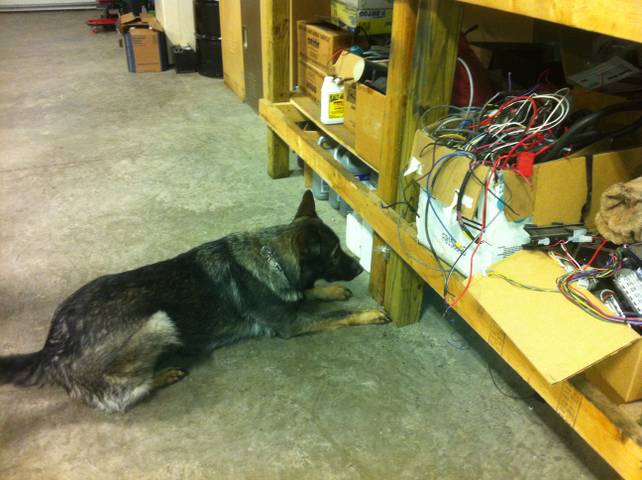
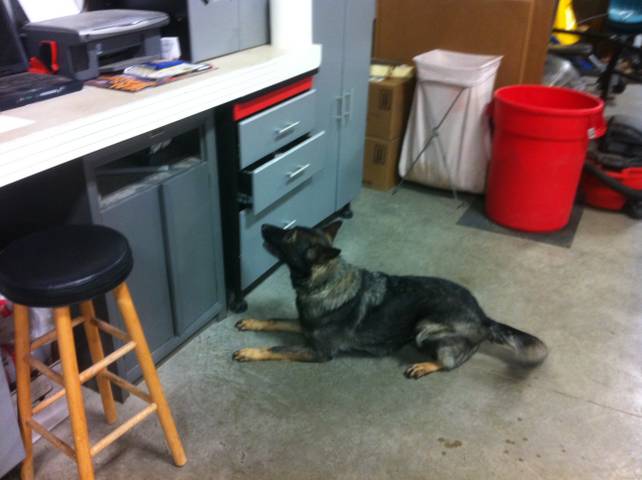
Laila Belle von den Sportwaffen
I selected my police dog Paco for a few reasons. He was imprinted and foundation trained and certified on only live narcotics. He had never been exposed to any form of pseudo or alternative training aids. He was a street proven dog who has proven reliable in any environment in the detection of narcotics. Paco had been trained on both small weight and large, bulk weight, narcotics. He consistently immediately alerts to narcotic odor with a very solid indication of source odor in training environments and does not offer false alerts. The Scentlogix Detection Aids were hidden in an area that had never been used for narcotic detection, in locations unknown to myself as the handler so no chance of subconsciously leading the dog could occur. No live narcotics were present or handled in any way on the test study day to eliminate any chance of residual odor contaminating the test location off environment, clothing, or human contact to the test. The odors were placed separately from each other. Without fail, K9 Paco exhibited strong behavior change when coming into odor and after locating source odor offered his final alert behavior. His behavior change and alert behavior were consistent with previous behavior and alert response in training and on the street when locating live narcotics. This satisfied my question as to whether a trained detection dog, having been trained on live narcotics only, would identify the Scentlogix Detection Aids on first contact exposure.
For the second half of the study I would now need to train a green dog with no previous exposure to narcotics. Further, I wanted a dog that had never been exposed to any scent detection training whatsoever, a clean slate to work with. Everything they would know would be what I had taught them. For this dog I used a breeding female from my kennel handled by my training partner, Lorna Thomas. The female selected was already known to me for her ball drive, hunt drive, scent ability, and focus. She had no environmental issues or nerve deficiencies of any kind. This was important to me because I wanted to be absolutely positive I had a viable detection dog candidate that I was certain could be trained on live narcotics just like the others I have trained. I did not want to risk having a dog wash out of the Scentlogix Detection Aid training, and then have any doubt later should the next dog pass if it was a training aid problem that caused the wash out or if it was a dog selection problem. Feeling confident the dog was a very viable and competent candidate for detection training, I then looked to the handler. I wanted Lorna to handle the dog under my direction for a few reasons. She had never trained a detection dog and would bring in no hidden tricks or pre-conceptions. She also was not a police officer and had zero ability to use narcotics in her training outside my presence. She only had access to the Scentlogix Detection Aids and she only trained in my presence and under my supervision. Lastly, the dog was not going to be used as a police k9 so if the dog washed out at the fault of the Scentlogix Detection Aids we had not caused a problem in a working street police k9, and therefore, Lorna had no incentive to make the dog pass or fail unfairly. The training would be done exactly the same as I would imprint and foundation live narcotic detection and the dog would either succeed or point to a fault in the aids used. The green dog used, Laila, consistently and immediately alerted to Scentlogix Detection Aids odor with a very solid indication of source odor in training environments and was trained not to offer false alerts. The Scentlogix Detection Aids were hidden in an area that had never been used for narcotic detection, in locations unknown to the handler so no chance of subconsciously leading the dog could occur. Without fail, Laila exhibited strong behavior change when coming into odor and after locating source odor offered her final alert behavior. For her final certification, Laila was tested on first contact exposure to live odor narcotics. This was done at a location where no Scentlogix Detection Aids had ever been present. None were present or handled in any way on the certification day to eliminate any chance of residual odor contaminating the test location off environment, clothing, or human contact to the certification test. Without fail, Laila exhibited strong behavior change when coming into live narcotics odor and after locating source odor offered her final alert behavior. Her behavior change and alert behavior were consistent with previous behavior and alert response in training with the Scentlogix Detection Aids. The live odor narcotics amounts were hidden in varied, furniture-filled rooms in locations unknown to the handler. Laila performed her narcotic search off lead as well, to remove any handler interaction or influence. The narcotics hidden consisted of the following:
Meth, 24 grams
Marijuana, 16 grams
Marijuana, 50 grams
Cocaine, 23 grams
Crack Cocaine, 2 grams
Heroin, 14 grams
Ecstacy, 3 grams
This satisfied my question as to whether a trained detection dog, having been trained on Scentlogix Detection Aids only, would identify live narcotics on first contact exposure. We then subsequently trained a total of three more dogs using the same method and testing as described previously in this article. All three of these dogs certified successfully and subsequently identified live narcotics on the street off traffic stops immediately after completion of their training and certification. They include:
• Atze von den Sportwaffen, marijuana off sniff of outer vehicle, closed doors/windows.
• Laila Belle von den Sportwaffen, heroin off traffic stop sniff of personal items
• Nova von den Sportwaffen, heroin and marijuana off traffic stop sniffs of outer vehicle, closed doors/windows
• Car z Oravskej Doliny, heroin off traffic stop sniff of personal items
Nova von den Sportwaffen was then sold to a department in Arizona and I’m happy to report that on her very first day on the street she positively alerted from the exterior of a vehicle on a traffic stop, resulting in marijuana located inside a closed, sealed, gasketed glass jar.
Therefore, at the conclusion of this double blind study, it is my belief that ScentLogix Detection Aids are consistent with the scientific analysis performed by David Adebimpe that the detection dogs used were unable to distinguish between live odor narcotics and the ScentLogix Detection Aids. After witnessing the benefits and ease of use of the ScentLogix Detection Aids and the certification results, it is my professional opinion that they are an extremely valuable tool in the training of reliable narcotic detection dogs.